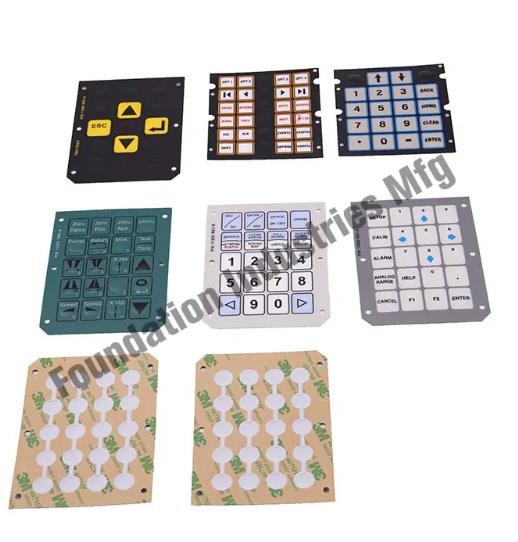Membrane: The membrane is a thin, flexible layer made of polyester or other similar materials. It is printed with conductive ink and serves as the interface between the user and the electronic circuit.
Overlay: The overlay is a thin layer of material that is applied over the membrane. It can be made of polyester, polycarbonate, or other materials, and is designed to protect the membrane from damage and provide a smooth surface for the user to interact with.
Adhesive: The adhesive layer is used to bond the membrane to the substrate. It is typically made of acrylic or other similar materials.
Circuit layer: The circuit layer is a printed circuit made of conductive ink that is applied to the membrane. It includes contact pads, traces, and other components that form the electronic circuit.
Spacer layer: The spacer layer is a non-conductive layer that separates the circuit layer from the substrate. It can be made of polyester or other similar materials.
When a user presses a button or activates a switch on the overlay, the membrane flexes and makes contact with the conductive ink on the circuit layer, completing the electronic circuit and sending a signal to the device. Membrane switches are known for their durability, reliability, and ease of use, making them a popular choice in a wide range of applications.
Membrane switches offer several advantages over other types of user interfaces, including mechanical switches and touch screens. Here are some ways in which membrane switches compare to other types of user interfaces:
Durability: Membrane switches are generally more durable than mechanical switches, which can wear out or break over time. They are also more resistant to damage than touch screens, which can crack or scratch.
Customization: Membrane switches can be customized to a wide range of shapes, sizes, and designs, making them ideal for a variety of applications. Mechanical switches and touch screens are generally less customizable.
Tactile feedback: Membrane switches can provide tactile feedback to the user when a button is pressed. This can help improve user experience and reduce errors. Touch screens do not provide tactile feedback, which can make it difficult for users to know if their input has been registered.
Cost: Membrane switches are generally less expensive than touch screens, which require more complex hardware and software. They are also more cost-effective than mechanical switches over the long term, as they require less maintenance and are less prone to failure.
Ease of use: Membrane switches are generally easy to use, China membrane switch suppliers with simple and intuitive interfaces. They require minimal training and can be operated by a wide range of users. Touch screens can be more complex and require more training, while mechanical switches can be difficult to use for those with limited dexterity or mobility.
Overall, membrane switches offer several advantages over other types of user interfaces, including durability, customization, tactile feedback, cost-effectiveness, and ease of use. These advantages make them a popular choice for a wide range of applications, from consumer electronics to medical devices and industrial controls.

Copyright:@2020-2021
Comments Please sign in or sign up to post.
0
0 of 500 characters used